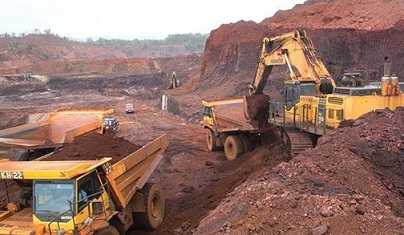By Our Correspondent
JODA/BARBIL/BHUBANESWAR: With mining auction going on, officials of several leading mining and steel companies have made beeline to Odisha’s mineral rich Joda circle in Keonjhar district. The Odisha Government has sought bids for 8 iron ore mines under Joda circle in first phase of notification.Apart from the present lease holders, officials Arcelor-Mittal, Tata Steel, Tata Steel Long Product Sponge Ltd, TS Alloys, Ramgarh Mining Mineral Ltd, MSPL and few others visited Joda to take stock of the ground situation.
KJS Ahluwalia owns Nuagaon Iron Ore Mines, Thakurani Iron Ore Mines of KJS’s sister concern Kapyee Enterprises, Jajang Iron Ore Mines of Rungta Mines Pvt Ltd, Rungta Sons Pvt Ltd Silijoda, Kalimati, Jhiling Iron Ore Mines of Essel Mining and Industries Ltd, Jaribahal Iron Ore Mines of Patnaik Minerals Pvt Ltd, Roida-(II) Iron Ore Mines of KN Ram Mines Group, Jurudi Iron Ore Mines of Kalinga Mining Corporation are expiring by March 31, 2020.These 8 Iron Ore Mines considered as major in the State in terms of its reserve capacity.
Among the 8, Kamaljit and Prashant Ahluwalia running KJSA Mines, Kaypee Enterprise Pvt Ltd and Hima Ispat Pvt Ltd based in Keonjhar-Sundargarh range of Odisha. Apart from iron ore and manganese mines in Joda and Koira mining circles, Alhuwalias owns a sponge iron factory and a mining crusher unit. Besides, Kamal Sponge Steel & Power Ltd based at Satna-Madhya Pradesh with interests in sponge iron production and iron ore mining have applied for coal blocks in Jharkhand, Madhya Pradesh and Chhattisgarh.
Earlier, rampant illegal mining reported from Thakurani and Nuagaon iron ore mines owned by Ahluwalia family. Alhuwalia had been in dock for violation of Rule 37 of Mineral Concession Rules- 1960.KJS Ahluwalia has the lease right for Nuagaon and Panduliposi mines in Joda circle while Kaypee Enterprise, where Prashant Ahluwalia holds a key position, owns the Thakurani mines in the same area.
Sources closely monitoring the auction process of 22 from Odisha out of 250 Iron Ore Mines Lease will expire on 31 March, 2020 all over the country, however apprehended that auction process will not be completed before 31 March 2020.
“If auction will be completed getting statutory clearances will take long time even years together,” sources said adding it will take at least three long years to get other statutory licenses like Forest Clearance, Environment Clearance and a host of other clearances.
Odisha, being one of the top most leaders in Iron Ore production, similar situation will arise in 2020-21 as majority of Iron Ore Mines will face stoppage due to expiring of Mining Lease on 31 March.
Some of the Private Mining Companies leases are not expiring on March 2020, so that these Mining Lease Holders can boost up their production to help out the Steel Makers.
Meanwhile, the Union government plans a slew of reforms in the mining sector, including giving a big push to commercial mining to help attract investment and improve mineral production in the country.
As part of this, highly placed sources said the government would discontinue the practice of offering mining rights for mineral resources, including coal, to companies for captive use. Instead, a new hybrid mining lease agreement would be framed under which companies would be free to use extracted mineral both for captive use of end use plants (power, steel, cement etc) and commercial sale in the open market.
A high level committee headed by NITI Aayog vice chairman and having top representation from ministries of finance, mines, coal and environment, has suggested that all mines hence forth be auctioned for commercial production. For companies taking mines largely for captive use, 50 per cent of production from those mines would be permitted to be sold in the open market under the new hybrid lease agreement.
Sources said the government has accepted these recommendations and necessary changes in mineral laws would be made to allow the reform measures to take shape.
The high level committee has suggested that changes in grant of mineral rights with the option to do both captive and commercial mining may be applied prospectively for all exploration and mining activities.
In addition to extraction of main mineral, the hybrid model will also allow leaseholders to extract other minerals found in their mine lease area on payment of 10 per cent of the quoted revenue share for the main mineral.
For existing captive mines allocated before the auction mechanism was made mandatory for grant of mineral leases, the high level committee has suggested the companies can use surplus mineral in their new end-use units formed under a joint venture agreement with a minimum 26 per cent shareholding.
Mining has been identified as a critical activity that needs a big push to help other capital intensive and employment generating industries. The sector is braving a slowdown that has seen declining investment and production.






























